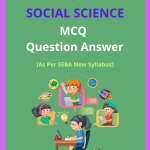SEBA Class 8 Social Science MCQ Chapter 22 The Constitution and its Necessity Solutions in English Medium, Class 8 Social Science Multiple Choice Question Answer to each chapter is provided in the list so that you can easily browse throughout different chapters SEBA Class 8 Social Science MCQ Chapter 22 The Constitution and its Necessity Question Answer and select need one.
SEBA Class 8 Social Science MCQ Chapter 22 The Constitution and its Necessity
Also, you can read the SCERT book online in these sections SEBA Class 8 Social Science Objective Type Solutions by Expert Teachers as per SCERT (CBSE) Book guidelines. These solutions are part of SCERT All Subject Solutions. Here we have given Assam SEBA Class 8 Social Science MCQ Solutions for All Subject, You can practice these here.
The Constitution and its Necessity
Chapter – 22
| MCQ |
1. What is the name of the written document that incorporates the rules for the functioning of a country?
(a) Constitution.
(b) Law.
(c) Policy.
(d) Code.
Answer: (a) Constitution.
2. Why is a constitution necessary for a country?
(a) To establish a monarchy.
(b) To ensure smooth functioning and provide security to citizens.
(c) To limit the power of the judiciary.
(d) To promote a specific religion.
Answer: (b) To ensure smooth functioning and provide security to citizens.
3. What do you understand by “amendment” to the constitution?
(a) Changing the entire constitution.
(b) The process of making changes to the constitution.
(c) A suggestion for improving the constitution.
(d) A new constitution replacing the old one.
Answer: (b) The process of making changes to the constitution.
4. Which of the following is NOT a characteristic of a constitution?
(a) It is a set of written rules and principles.
(b) It determines relationships between government organs.
(c) It provides for fundamental rights and duties.
(d) It is a static document that never changes.
Answer: (d) It is a static document that never changes.
5. How does a constitution contribute to individual freedom and rights?
(a) By limiting the power of the government.
(b) By promoting a specific ideology.
(c) By establishing a rigid social hierarchy.
(d) By encouraging conformity.
Answer: (a) By limiting the power of the government.
6. Which of the following is NOT one of the three organs of government as outlined in the constitution?
(a) Executive.
(b) Legislature.
(c) Judiciary.
(d) Military.
Answer: (d) Military.
7. What role does the constitution play in elections?
(a) It determines the eligibility criteria for voters.
(b) It outlines the process of electing representatives.
(c) It ensures fair and free elections.
(d) All of the above.
Answer: (d) All of the above.
8. How does the constitution promote a planned and organized way of functioning for a country?
(a) By dividing powers and functions among different organs.
(b) By establishing a rigid hierarchy.
(c) By centralizing all power in the executive.
(d) By ignoring regional differences.
Answer: (a) By dividing powers and functions among different organs.
9. What is the primary purpose of a constitution?
(a) To establish a monarchy.
(b) To ensure the smooth functioning and security of citizens.
(c) To limit the power of the judiciary.
(d) To promote a specific religion.
Answer: (b) To ensure the smooth functioning and security of citizens.
10. What are the two main types of constitutions?
(a) Written and unwritten.
(b) Flexible and rigid.
(c) Democratic and authoritarian.
(d) Federal and unitary.
Answer: (a) Written and unwritten.
11. What are the key characteristics of a written constitution?
(a) It is flexible and easily changed.
(b) It is based on customs and traditions.
(c) It is clear, definite, and authoritative.
(d) It is unwritten and based on precedent.
Answer: (c) It is clear, definite, and authoritative.
12. What is an unwritten constitution?
(a) A constitution that is not formally written down.
(b) A constitution that is based on religious laws.
(c) A constitution that is enforced by the military.
(d) A constitution that is only followed by certain groups.
Answer: (a) A constitution that is not formally written down.
13. What are the key characteristics of an unwritten constitution?
(a) It is based on customs, traditions, and judicial decisions.
(b) It is easily amended and changed.
(c) It is clear and definite.
(d) It is enforced by a strong central government.
Answer: (a) It is based on customs, traditions, and judicial decisions.
14. What is a flexible constitution?
(a) A constitution that can be easily amended.
(b) A constitution that is difficult to change.
(c) A constitution that is based on religious laws.
(d) A constitution that is enforced by the military.
Answer: (a) A constitution that can be easily amended.
15. What are the key characteristics of a flexible constitution?
(a) It is rigid and difficult to change.
(b) It requires special procedures for amendments.
(c) It can be easily amended by the legislature.
(d) It is based on customs and traditions.
Answer: (c) It can be easily amended by the legislature.

Hi! my Name is Parimal Roy. I have completed my Bachelor’s degree in Philosophy (B.A.) from Silapathar General College. Currently, I am working as an HR Manager at Dev Library. It is a website that provides study materials for students from Class 3 to 12, including SCERT and NCERT notes. It also offers resources for BA, B.Com, B.Sc, and Computer Science, along with postgraduate notes. Besides study materials, the website has novels, eBooks, health and finance articles, biographies, quotes, and more.




